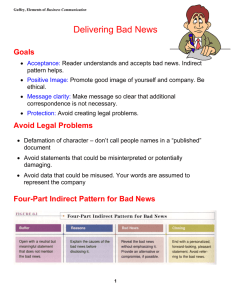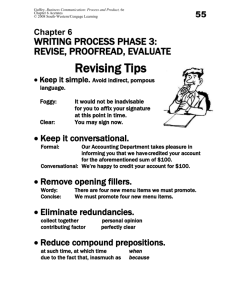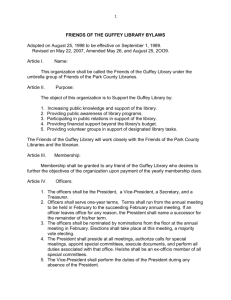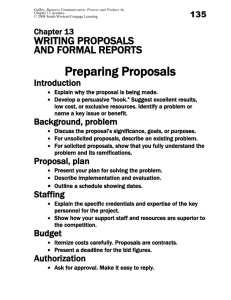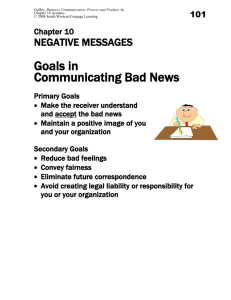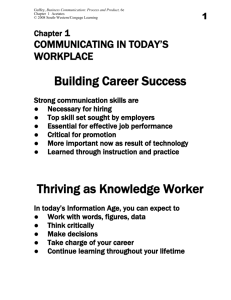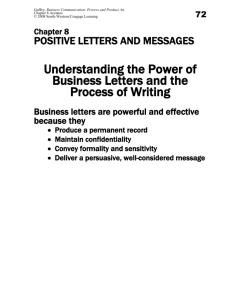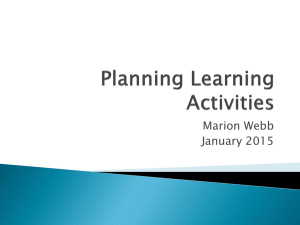Components of a Persuasive Message
advertisement
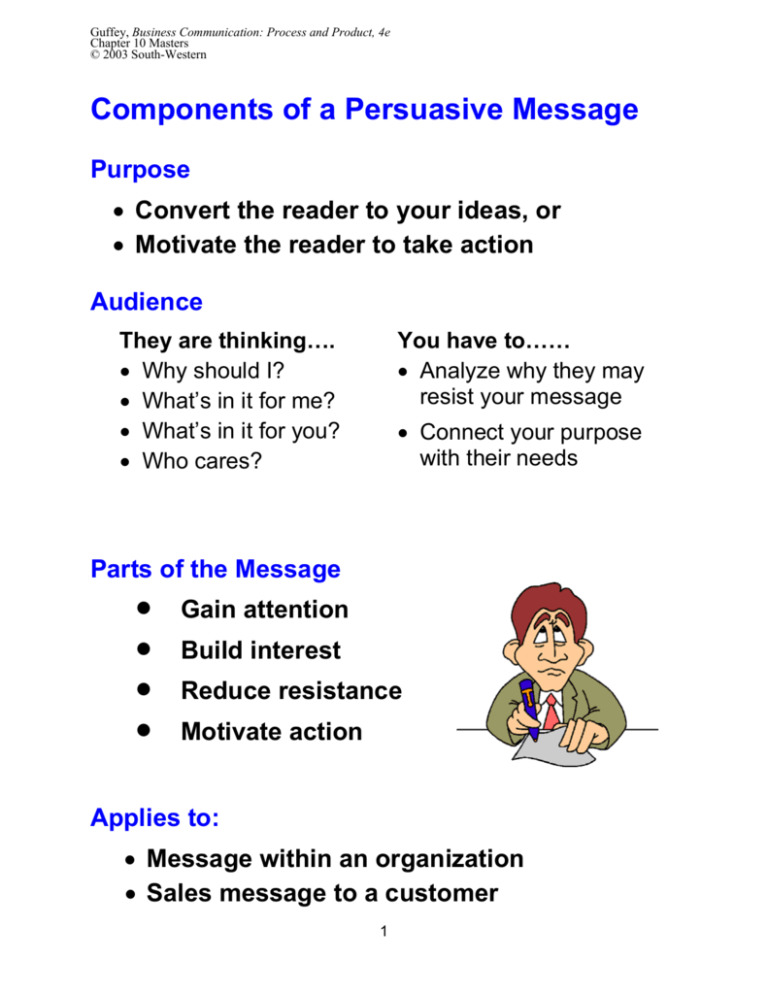
Guffey, Business Communication: Process and Product, 4e Chapter 10 Masters © 2003 South-Western Components of a Persuasive Message Purpose • Convert the reader to your ideas, or • Motivate the reader to take action Audience They are thinking…. • Why should I? • What’s in it for me? • What’s in it for you? • Who cares? You have to…… • Analyze why they may resist your message • Connect your purpose with their needs Parts of the Message • • • • Gain attention Build interest Reduce resistance Motivate action Applies to: • Message within an organization • Sales message to a customer 1 Guffey, Business Communication: Process and Product, 4e Chapter 10 Masters © 2003 South-Western Making Persuasive Requests Gain attention • Requesting favors: begin with a compliment, unexpected fact, stimulating question, reader benefit, summary of problem, or candid plea for help. • Claims: open with a review of the action you have taken to resolve the problem. Build interest • Prove the accuracy and merit of your request with facts, figures, expert opinion, examples, and details. • Avoid sounding high-pressured, angry, or emotional. • Suggest direct and indirect benefits for the receiver. Direct Benefit: If you accept our invitation to speak, you will have an audience of 50 potential customers for your products. Indirect Benefit: Your appearance would prove your professionalism and make us grateful for your willingness to give something back to our field. 2 Guffey, Business Communication: Process and Product, 4e Chapter 10 Masters © 2003 South-Western Reduce resistance • Identify possible obstacles; offer counter arguments. • Demonstrate your credibility by being knowledgeable. • In requesting favors or making recommendations, show how the receiver or others will benefit. Example: Although your gift to the Neonatal Care Center is not tax deductible, it would help us purchase one Intensive Care Ventilator. This unit would be put to use immediately in caring for critically ill and premature newborn infants. Motivate action • Ask for specific action confidently. • Include an end date, if appropriate. • Repeat a key benefit. 3 Guffey, Business Communication: Process and Product, 4e Chapter 10 Masters © 2003 South-Western Questions to Ask when Writing a Request 1. What is the purpose of the letter ? 2. How do you think the reader will react to the message? 3. What could be used to attract the attention of the reader in the opening? 4. What information could be used to build interest in the body? 5. What are some of the arguments the receiver might offer to resist the request? Could any counter arguments be offered? 6. What could be used to motivate the reader to accept or comply to the request? 7. Should an end date be used in the closing? What information could be added to the closing to make it easier for the receiver to respond? . 4 Guffey, Business Communication: Process and Product, 4e Chapter 10 Masters © 2003 South-Western Ineffective Persuasive Invitation Dear Dr. Thomas: Because you’re a local Atlanta author, we thought it might not be too much trouble for you to speak at our GSU Management Society banquet May 5. Some of us business students here at Georgia State University admired your book Beyond Race and Gender, which appeared last spring and became such a hit across the nation. One of our professors said you were now the nation’s diversity management guru. What exactly did you mean when you said that America is no longer a melting pot of ethnic groups--it’s an “American mulligan stew”? Because we have no funds for honoraria, we have to rely on local speakers. The Reverend James R. Jones and Vice Mayor Rebecca A. Timmons were speakers in the past. Our banquets usually begin at 6:30 with a social hour, followed by dinner at 7:30 and the speaker from 8:30 until 9 or 9:15. We can arrange transportation for you and your guest, if you need it. We realize that you must be very busy, but we hope you’ll agree. Please let our advisor, Professor Alexa North, have the favor of an early response. Sincerely yours, 5 Guffey, Business Communication: Process and Product, 4e Chapter 10 Masters © 2003 South-Western Persuasive Invitation -- Rewrite Dear Dr. Thomas: Your book Beyond Race and Gender stimulated provocative discussion across the nation and on our campus when it first appeared last spring. Business students at Georgia State University now consider you the nation’s diversity management guru, and for that reason they asked me to use all my powers of persuasion in this invitation. Because we admire your work, we’d like you to be our keynote speaker at the GSU Management Society banquet May 5. As students at an urban campus in a metropolitan area, we’re keenly aware of diversity issues. In your words, America is no longer a melting pot of ethnic groups; it is now an “American mulligan stew.” We’d like to hear more about the future workforce and how managers can maximize the contribution of all employees. Although we can’t offer you an honorarium, we can promise you a fine dinner at the GSU Faculty Club and an eager and appreciative audience of over 100 business students and faculty. Speakers in the past have included the Reverend James R. Jones and Vice Mayor Rebecca A. Timmons. 6 Guffey, Business Communication: Process and Product, 4e Chapter 10 Masters © 2003 South-Western Dr. Thomas Page 2 Current date The evening includes a social hour at 6:30, dinner at 7:30, and your remarks from 8:30 until 9 or 9:15. So that you won’t have to worry about transportation or parking, we will arrange a limousine for you and your guest. Please make this our most memorable banquet yet. Just call our adviser, Professor Alexa North, at 356-9910 before April 1 to accept this invitation. Sincerely yours, 7 Guffey, Business Communication: Process and Product, 4e Chapter 10 Masters © 2003 South-Western Writing Sales Letters Gain attention • Offer something valuable, promise a significant result, or describe a product feature. • Present a testimonial, make a startling statement, or show the reader in an action setting. Example: How much is sex costing your company? An incident of sexual harassment can cost millions of dollars unless preventive measures are taken. Build interest • Describe the product in terms of what it does for the reader. • Show how the product or service saves or makes money, reduces effort, improves health, produces pleasure, or boosts status. Example: Our computer-based training program teaches your employees what behavior is acceptable and unacceptable, while showing you steps to reduce the risk of employer liability. 8 Guffey, Business Communication: Process and Product, 4e Chapter 10 Masters © 2003 South-Western Reduce resistance • Counter reluctance with testimonials, moneyback guarantees, attractive warranties, trial offers, or free samples. • Build credibility with results of performance tests, polls, or awards. Example: This important investment in sexual harassment prevention comes with a money-back guarantee. If you are not satisfied, your entire training costs are returned. Motivate action • Close with repetition of the central selling point and clear instructions for an easy action to be taken. • Prompt the reader to act immediately with a gift, incentive, limited offer, or deadline. • Put the strongest motivator in a postscript. Example: Sign up now and you receive a free 60-day trial. Call, fax, or e-mail us today to receive a free demo disk. You can’t lose! 9 Guffey, Business Communication: Process and Product, 4e Chapter 10 Masters © 2003 South-Western Gaining Attention Samples • Problem description Six of our computers were recently infected with the ‘Melissa’ virus, and we lost at least 25 work hours trying to repair the problem. • Unexpected statement If you checked carefully, you’d probably find that 20 percent of your customers account for 80 percent of your profits. • Reader benefit Now you can immediately protect all your computers from the latest viruses with our online anti-virus program. • Compliment Because no one generates as much audience enthusiasm as you do in your presentations, we are asking you to speak . . . . • Related fact A virus is a computer program written to perform malicious tasks. • Stimulating question How would you like to cut employee overtime costs in half? 10 Guffey, Business Communication: Process and Product, 4e Chapter 10 Masters © 2003 South-Western Building Interest Samples • Supply facts and figures. Currently 16,000 known computer viruses are in effect, and the number increases by 300 to 400 each month. • Give examples. One company lost valuable data and had no recent backup disks to replace infected files. • Cite expert opinion. “Hostile code can hit without warning,” says virus specialist Dr. Tony Timm, “so companies must have a virus antidote or they risk all their operations.” • Provide specific details. In a test comparing six of the leading anti-virus programs, our program was flawless in virus detection, easy to administer, and low in ownership cost. • Mention direct benefits. Our anti-virus program can protect you from subtle corruptions of data that may go unnoticed for months. • Mention indirect benefits. Your company continues to be a pacesetter in the health care industry by setting an example for other organizations that are bewildered with the increasing number of viruses. 11
